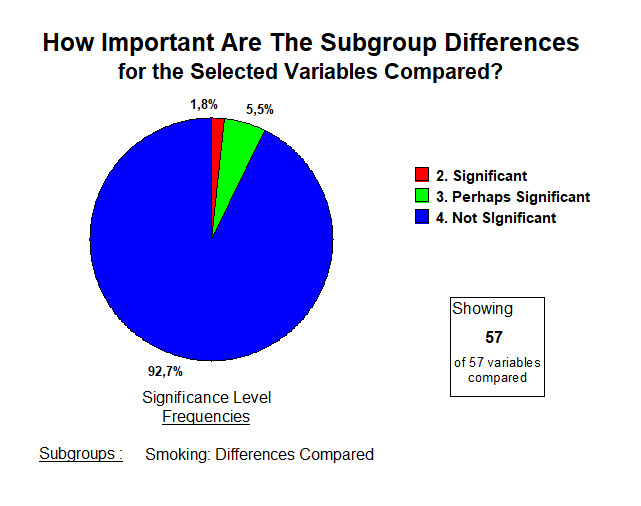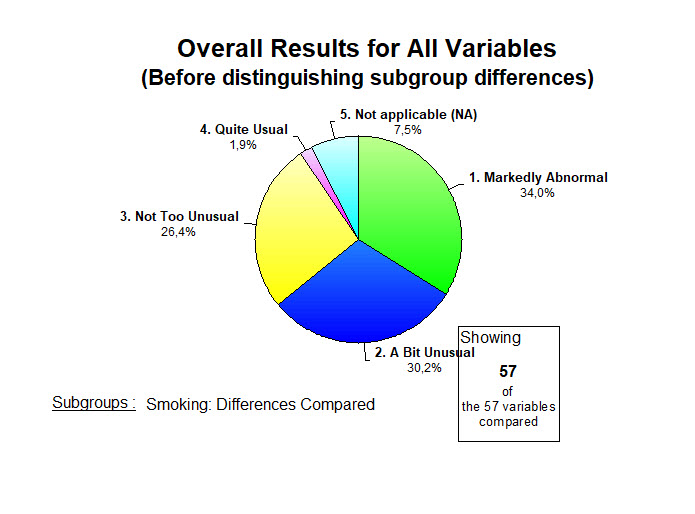Comparing Smokers & Non-Smokers with "Long-term" COVID-19
LTCOVID.com
Thanks for visiting!
To translate this page, select your
language from the dropdown menu below:
As we add comparisons like this one, there are certain traps that may mislead our studied conclusions.
These always take place in a larger context. And as important, finding a difference, even if statistically significant, doesn't always explain it's cause. And finally, discovering that certain apparent differences as one glances at the results, are not significant after statistical control, can be equally important. It says: "for this variable, they are the same": very often useful. Often less exciting for a researcher.
So before looking for those "significant differences" that attract attention, what should one note about
Smokers and Non-Smokers in our sample of 136 respondents?
-
- They all present as having "long-term" COVID-19. So if smoking or not before becoming infected is important, here we can say that our entire sample of respondents presented as having the illness. 100% if we believe all respondents that they have it. That's the context.
- 54.81% of our total sample of 136 are Non-Smokers & 40% are Smokers. That does not add up to 100% because some preferred not to tell. But 61 total smokers, compared with 75 non-smokers should be enough to find important differences related to smoking if they are there.
- In the United States, 13.7% of the population smokes. In the United Kingdom, 14.7%. So a sample where 40% are Smokers, is already clearly different then the populations from which that sample was drawn. Conclusion: Smoking is clearly more associated with having COVID-19, or at least it's "long-term" variant. It says the equivalent of "if you smoke, prepare yourself to land in the "long-term" COVID-19 group if you become infected with the SARS-CoV-2 virus." That conclusion seems defensible.
Smoking or Not with "long-term" COVID-19 : Differences ?
In what follows: Grp 1 = Smokers; Grp 2 = Non-smokers
Here is their long list.
57 variables compared, and reported here sorted by calculated levels of significance.
You will quickly notice that
- most differences did not prove to be statistically significant. (51 of 57)
- no differences calculated to a result of "1. Very SIgnificant"
Only 6 differences pass muster under statistical control. Of these 4 belong to the category of
"3. Perhaps Significant."
Let's make these easier to read ...
(You can click on the image and it will enlarge).
And ?
- Smokers find that their "long-term" COVID-19 illness is slightly less Physical, but more Emotional.
- They took nutritional supplments, or obtained tests related to levels of things like Vitamin-D, less often than the Non-smokers.
- Smokers projected a return of Quality of Life in 1 Year, that is less than Non-smokers. Not a large difference, but suggests a little less hope for the future among the Smokers.
- Smokers had a smaller body size (BMI) before illness began than the Non-smokers. Overall, the entire group (136) of respondents was on average overweight. Based on figures from the populations from which they were drawn. They are not alone faing issues of weight.
- For those who became ill, who had experienced feeling better, then feeling worse again which we'll call a recurrence, that recurrence arrived sooner in the Smokers. A p-value of 0.1615 means some will dismiss this difference as not significant. It may nevertheless be trying to teach us something about the potential association of this disease and its recuurence, with smoking.
- The Quality of Life lost during the illness, and due to the illness, was seen as slightly greater among Smokers.
So what are the overall frequencies of significance for the differences between Smokers and Non-Smokers, 2 subgroups of the larger sample of respondents presenting with "long-term" COVID-19?
Glad you asked. They look like this ...
"So why even bother with this comparison?" - some might ask.
Just for the sake of emphasis, I repeat here that results that are mathematically "4. Not Significant" may still be of value. May still teach us something important.
Here's 1 example, the variable "Difficulty Concentrating" :
-
-
- 83.6% of our Smoking respondents had selected this suggested responce.
- 85.3% of Non-smokers selected that variable as present in their lives due to this illness.
- Very little difference, and not statistically significant.
- If one had a study with 10 000 respondents, such a difference might become significant or "a real difference." If that were the case, smoking would seem to prevent "Difficulty Concentrating." A ridiculous suggestion, but we don't have those data yet! Sometimes such larger studies, by identifying and emphasizing miniscule differences, miss the obvious. They can lead horribly astray. That's a forest versus trees situation.
- More to the point: Independent of whether they smoke or not, more than 80% of individuals presenting through our questionnaire with the "long-term" variant of COVID-19 have "Difficulty Concentrating." Why?
-
"Difficulty Concentrating" might be an emotional problem. Hard to concentrate when one is Anxious, Fearful, Frustrated and Impatient, as many of our respondents indicated being. So it probably has, this concentration problem, an emotional component.
Of course, a Neurologic cause for "Difficulty Concentrating" is strongly supported as wall.
Smokers and Non-smokers both, indicated that their Nervous System was affected. 67.2% for the Smokers, and 73.3% for the Non-smokers. And as said, that difference did not reach significance mathematically.
But autopsy studies conducted by Pathologists of brains infected by SARS-CoV-2 support our respondents' opinions: their impressions that their brains (even without a brain biopsy), are not quite right just yet.
So it's likely to be: both Physical and Emotional.
A result of "4. No Significant Difference" just attracted our attention to that.
So concentrate on that for just a moment.
-------
A parting word or two.
If we put the Smokers and Non-Smokers back together again (not in the same room please. Second-hand smoke would convert them all to Smokers), just how abnormal are the results?
Overall, for each of these 57 variables studied, how out of the ordinary are these problems under study?
So almost 3/4's of the Smoker/ Non-smoker respondents are faced with results that vary from "Markedly Abnormal" (34%) to at least, "A Bit Unusual" (30%).
What other results are we waiting for, to try to bring this illness to an end?
Enough Is Enough.
The Energetics of all of this >>>>>>>
<<<< Show me Other Comparisons
<<<<<<< Home





